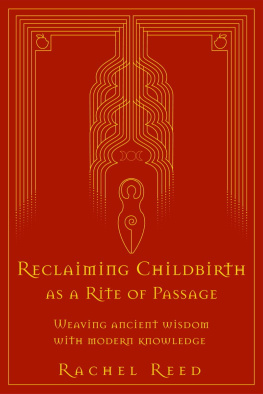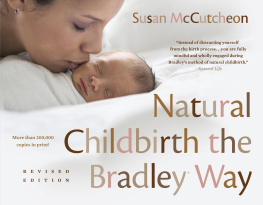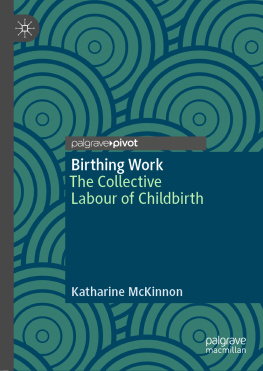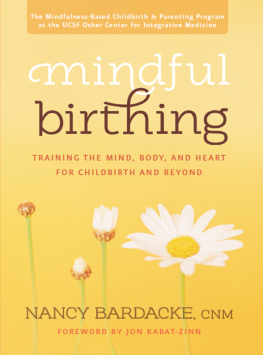There is nothing more important than how we are born. We have forgotten this simple fact for far too long. Ina Mays Guide to Childbirth, as well as her earlier volume, Spiritual Midwifery, is all we need to reconnect to the empowering beauty of childbirth that is womans amazing gift for people-ing the earth.
Few books have the potential to improve the life of everyone born on the planet. This one does.
Alice Walker, author of The Color Purple
Not only is Ina May Gaskin the most famous midwife in the U.S.; indeed, she is the most famous midwife in the world! This book will show you why. Ina May learned about birth in the most direct way possiblefrom attending births. Through the stories she tells in this exciting new book, women can experience her learning process. As Ina May learned, so her readers will learn about themselves, their bodies, and their abilities as birth-givers. And she will guide them through the maze of new obstetrical technologies, showing them the way toward wise decisions and fully informed choices.
Robbie Davis-Floyd, author of Birth as an American Rite of Passage

INA MAYS GUIDE TO CHILDBIRTH
A Bantam Book / March 2003
Published by Bantam Dell
A Division of Random House, Inc.
New York, New York
This book provides information and stories about alternative approaches to birth care. This book should not be substituted for the personal care of a qualified physician or midwife, but should be used only to consider and become familiar with the full range of birthing options that are available today. The author and publisher are not responsible for any adverse effects resulting from the use of information contained in this book.
All rights reserved.
Copyright 2003 by Ina May Gaskin
Line art by Jackie Aher
For photograph and illustration credits, see
No part of this book may be reproduced or transmitted in any form or by any means, electronic or mechanical, including photocopying, recording, or by any information storage and retrieval system, without written permission from the publisher, except where permitted by law.
Bantam Books is a registered trademark of Random House, Inc., and the colophon is a trademark of Random House, Inc.
Library of Congress Cataloging-in-Publication Data
Gaskin, Ina May.
Ina Mays guide to childbirth / Ina May Gaskin.
p. cm.
eISBN: 978-0-307-48625-7
1. Childbirth. I. Title: Guide to childbirth. II. Title: From the nations leading midwife Ina Mays guide to childbirth. III. Title.
RG661.G376 2003
618.45dc21
2002029901
Cover design: Beverly Leung
v3.1
A N OTE OF T HANKS
I want to thank my husband, Stephen Gaskin, for his unfailing willingness to help me during the long process of writing this book. I literally could not have done this project without him. My thanks go also to my agent, Stephany Evans; Pamela Hunt; Carol Nelson; Deborah Flowers; Joanne Santana; Sharon Wells; Pamela Maurath; John O. Williams, Jr., MD; Wendy Savage, MD; A. Mark Durand, MD; Alan Graf; Anna Meenan, MD; Joseph Bruner, MD; Marsden Wagner; Kenneth Johnson; David Frohman; Leigh Kahan; Robbie Davis-Floyd; Elise Harvey; Leslie Hunt; Dana Gaskin Wenig; Claudia Oblasser; Angelika Rodler; Michael Stohrer; Verena Schmidt; Betty Anne Daviss; and Ken Starratt. I would also like to thank my editors, Robin Michaelson and Beth Rashbaum, and their assistant, Stacie Fine.
Ina May Gaskin, CPM
C ONTENTS
A N I NVITATION
W hatever your reason for picking up this book, I salute your curiosity and your desire to know more about the important work of having babies. For those who are pregnant, I kept you especially in mind as I wrote this book.
Consider this your invitation to learn about the true capacities of the female body during labor and birth. Im not talking about a summary of current medical knowledge translated from technical to popular language. You can find plenty of that in bookstores. What I mean by true capacities of the female body are those that are experienced by real women, whether or not these abilities are recognized by medical authorities. The way I see it, the most trustworthy knowledge about womens bodies combines the best of what medical science has offered over the past century or two with what women have always been able to learn about themselves before birth moved into hospitals. The purpose of this book is to point you toward the best information currently available about womens real capacities in labor and birth and to show you how these can mesh with the most effective use of modern birth technology. My intention is to encourage and inform you.
I have been a community midwife for more than three decades. I live in a village in the United States in which women and girls have little or no fear of childbirth. My partners and I have attended the births of more than 2,900 babies, most of them born in their parents homes or at our birth center. Working in this way has enabled me to learn things about women that are generally unknown in the world of medical education. Its not easy to say whether the women in my village have less fear of birth because we know that our capabilities go beyond medical understanding or that our capabilities are greater without anxiety. Actually, both are true.
The village is called The Farm, and its located in southern Tennessee, near Summertown. My husband and I, along with several hundred others, founded it in 1971, and there we still live and work. One of the unique features of our community is that, from its beginning, the men have not interfered with the womens desire to organize our own system of birth care. At the same time, the men have always lent a good deal of support and technological expertise to make our care more readily accessible and available. They have never dictated where or how our babies would be born.
Let me be clear about what I say about fear and birth at The Farm. I dont mean that these women in my village never experienced a few moments of anxiety at the prospect of giving birth or wondered, Will I be able to accomplish this seemingly impossible act? Im sure that many of us did wonder about this from time to time. Virtually all women do. After all, it is not immediately obvious to most people who grow up in civilized culturesespecially those in which most people live totally apart from animalshow birth can happen. When such moments of doubt occur to women in my village, they are able to fall back on the sure knowledge that their closest friends and sisters and mothers have been able to do it. This knowledge then makes it possible for them to believe that they can toowhether or not theyve ever witnessed the act of birth itself. The women at The Farm have relearned and been highly successful at kinds of female behavior that modern women in civilized cultures arent known to be good atthose that go beyond the common medical understanding of womens bodies and birth.
My experiences as a midwife have taught me that womens bodies still work. Here is your chance to be exposed to a new understanding of an ancient system of knowledge that you can add to your general understanding of what birth means. Wherever and however you intend to give birth, your experience will impact your emotions, your mind, your body, and your spirit for the rest of your life.
The women in my villagerare for the women who give birth at The Farm. (Our cesarean rate up to the year 2000 was 1.4 percent; our forceps- and vacuum-extraction rate was 0.05 percent. The U.S. national cesarean rate for 2007 was 32.3 percent, and the instrumental delivery rate was about 10 percent.) Women at The Farm know that labor can be painful, but many of them know as well that labor and birth can be ecstaticeven orgasmic. Above all, whether or not they experienced labor as painful, to a woman, they found labor and birth a tremendously empowering passage.
Next page







